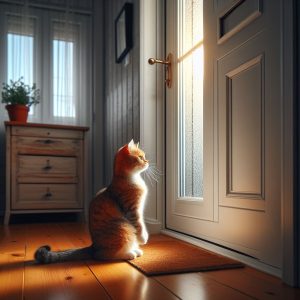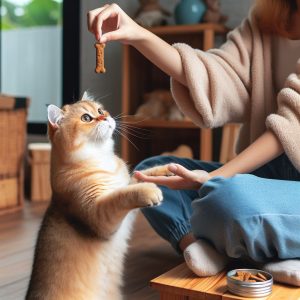The sound of heavy breathing and panting coming from your cat while you’re driving can be concerning. You look back and see your furry friend with their mouth open, tongue hanging out, breathing rapidly. Why do cats pant in the car? What does it mean and what can you do about it?
Cats panting and drooling in the vehicle is a common feline response. The motion of the moving car can cause anxiety, nausea, overheating, and stress in some cats. Understanding the reasons behind this behavior is the first step to creating a more comfortable ride for your kitty.
In this comprehensive guide, we’ll explore the causes of panting in the car, tips to prevent it, and how to manage a cat who pants during every trip. With proper preparation, training, and care, you can help nervous kitties stay relaxed on car journeys.
Why Cats Pant in Cars
There are several explanations for why cats may pant, breathe heavily, and be distressed in automobiles:
Motion Sickness
One of the most common reasons for drooling and heavy breathing in the car is motion sickness. The movement from the vehicle can upset a cat’s sensitive inner ear balance, creating nausea and vomiting. Motion sickness is worse in younger kittens and cats who don’t travel often.
Anxiety and Fear
The unfamiliar car environment and engine noises can trigger anxiety in some cats when driving. The lack of control over the situation can cause panting and other distress behaviors. Anxious cats may pace, meow, claw, hide, or try to escape the carrier.
Overheating
Heat exhaustion is another cause of heavy breathing in cars. Cats release heat by panting when they get too hot. Windows and being in direct sunlight raise in-car temperatures. Kitties with long hair are most susceptible to overheating.
Medical Conditions
Underlying health issues like heart disease, fever, respiratory infections, poisoning, or hyperthyroidism may also lead to panting behaviors. Car rides can exacerbate these problems. Always consult your vet if you notice any unusual panting.
Psychology and Breed
A cat’s unique personality also plays a role. Skittish, excitable breeds like Siamese are more prone to car sickness. But any cat can become anxious or nauseous on the road, especially with unfamiliar driving conditions.
So in summary, the movement, noises, lack of control, heat, and potential health issues involved with car travel can all cause panting in feline passengers. Understanding why your particular cat pants will help you address the triggers.
Tips to Prevent Cats Panting in Cars
If your cat pants and drools on car trips, here are some handy tips to help prevent an anxious, overheated kitty:
Take Short Trips
For cats that get motion sickness easily, take short rides (10 minutes or less) to minimize nausea triggers. Gradually work up to longer distances as your cat adapts to being in a moving vehicle.
Use a Secured Carrier
Keep your cat in a well-ventilated carrier latched with a seatbelt for safety. This provides a cool, enclosed space for your kitty and stops escape attempts during the drive.
Give Cat Treats
Reward good behavior with tasty treats for a positive association. Provide treats when first placing your cat in the carrier, during the ride, and after. This reinforces calmness.
Utilize Calming Aids
Pheromone sprays, relaxing music, and toys in the carrier can help soothe anxious cats. Ask your vet about anti-nausea meds or supplements for motion sickness.
Lower Car Temperature
Keep the car cool with the A/C on and avoid direct sunlight. If it’s hot out, only transport cats when necessary and never leave them unattended in vehicles.
Take Frequent Breaks
Stop every 30 minutes on longer drives so your cat can rest. Open windows for fresh air. Offer a chance to use the litter box and give water.
Get Kitty Acclimated
For anxious cats, take them on short drives around the block with no destination to get them used to car travel. Make these practice drives relaxing by using treats and pheromones.
Stay Calm Yourself
Cats pick up on owners’ stress. Remain composed during the drive. Comfort your cat with a soothing voice and minimal handling. Getting upset makes cats more anxious.
With preparation and training, cars can become less intimidating for scaredy cats. Preventing overheating, nausea, and anxiety is key to help kitties stay relaxed and comfortable while driving.
How to Manage a Cat Who Pants in the Car
If your cat already pants heavily and drools on car trips, it takes patience and care to help them become a seasoned traveler. Here are some effective tips for managing an anxious, car-sick kitty:
Consult Your Vet
If car sickness is severe, talk to your vet. They can prescribe anti-nausea medication, sedatives, or pheromones to make travel easier on your cat.
Use a Covered Carrier
A sturdy plastic or hard-sided covered carrier provides a sense of security. It blocks out sights and sounds that could cause anxiety. Soft-sided carriers flex too much.
Prepare Essential Supplies
Pack towels, wipes, water, a litter box, plastic bags, disinfectant, and paper towels in case of accidents. Being prepared will make mishaps less stressful.
Minimize Unneeded Stops
Avoid sudden stops/starts. Stop signs and traffic lights can worsen nausea. Plan routes with minimal stopping when transporting carsick cats.
Distract and Entertain
Bring favorite toys and play calming music to help take your cat’s mind off the unpleasant aspects of travel. Use interactive toys they can bat or paw at.
Feed a Light Meal
Avoid feeding a large meal before the drive to minimize vomiting and diarrhea. Stick to a small serving of their usual food.
Use Feline Appeasing Pheromones
Feliway and other pheromone sprays or wipes help induce a sense of well-being in cats. Apply these synthetic facial pheromones in the carrier 15 minutes before transport.
Allow Time to Decompress
After the drive, give your cat quiet time to recover from the stress and stimulation. Set up a roomy, comfortable space with familiar items from home.
Clean Messes Thoroughly
Use an enzymatic cleaner to fully remove smells if your cat vomits or has accidents. Leftover odors may trigger repeat elimination in the same spots.
Try Anti-Nausea Medication
For severe motion sickness, your vet can prescribe medications like Cerenia to prevent vomiting and drooling. Use under veterinary guidance for best results.
With preparation, training, veterinary guidance, and TLC, carsick kitties can become more comfortable travelers. But progress takes time, so start with short trips and incrementally work your way up distance-wise. Pay attention to triggers and employ relaxation aids to support your cat.
Dealing with a Cat Who Drools in the Car
Excessive drooling in the vehicle often accompanies panting in distressed feline passengers. Here’s how to manage a cat with hypersalivation and nausea:
- Use towels or absorbent pads in carriers to soak up drool. Change pads as needed if they become wet.
- Wipe off your cat’s face and paws after the trip so they don’t ingest the drool while grooming.
- Discourage licking plastic carriers, which may contain chemicals. Provide safe toys for licking instead.
- Ask your vet about anti-nausea meds or sedatives to reduce drooling caused by motion sickness.
- Frequently swallowing drool can cause vomiting. Have waste bags ready just in case.
- Ensure your cat stays hydrated since drooling causes fluid loss. Offer water before/after rides.
- Drooling may indicate nausea, stress, or overheating. Take steps to address the root cause of the behavior.
- To prevent future drooling, take very short trips at first and use carriers that block motion perception.
- Reward calm behavior on car journeys with treats and affection to reinforce a positive association.
Excessive drooling indicates an unhappy cat. With care and training, you can help transform car rides from a dreaded experience into an easier, more comfortable trip.
FAQs About Cats Panting in Cars
Still have some questions about why cats pant and overheat in vehicles? Here are answers to some frequently asked questions:
Why does my cat pant so much in the car but is fine at home?
The motion of the car triggers nausea, anxiety, and loss of balance in some cats. Also, cars heat up quickly, causing panting not seen at home. Cats feel more secure at home versus a moving vehicle.
Is it safe to give a cat Benadryl for car sickness?
No, always consult your vet before giving any medication. Benadryl may cause harmful side effects in cats. Vets can prescribe safer anti-nausea drugs or sedatives for motion sickness if needed.
Should I take my panting cat to the vet?
Yes, if signs seem severe or chronic. Excessive, ongoing panting may indicate underlying medical issues needing treatment. Vets can check for heart disease, infections, dental disease, thyroid disorder, etc.
Can I give my carsick cat ice cubes to lick?
Yes, licking ice can help fussy travelers. The cool temperature is soothing, and licking is a distraction. Just give small ice cubes to avoid choking. Offer water before/after too.
Why does my cat yowl and pant in her carrier?
The confinement of a carrier triggers anxiety in some cats. Motion sickness also plays a role. Use padded, secure carriers with pheromones and treats to help create positive associations.
What’s better for car sickness – a plastic or fabric carrier?
Rigid plastic or hard carriers are ideal to minimize motion. They also allow for better temperature control. Soft carriers flex too much during braking/turning.
Understanding why your cat pants and providing proper care makes car trips less stressful for both of you. With training, aids, and short drives, kitties can become seasoned travelers.
Key Takeaways on Cats Panting in Cars
To summarize, here are the key points on managing cats who pant, drool and become distressed during car rides:
- Common Causes: Motion sickness, anxiety, overheating, and medical conditions can trigger panting in cars.
- Prevention Tips: Use carriers, pheromones, minimal driving, calming aids, A/C, and positive reinforcement.
- Be Prepared: Have cleaning supplies, restraints, water, medication, toys, towels, and litter box on hand.
- Consult a Vet: Rule out illnesses and get prescription anti-nausea/sedatives for chronic car sickness.
- Training: Take short trips first. Slowly increase distance. Make travel a positive experience.
- Stay Calm: Your own anxiety stresses cats. Be reassuring and minimize handling.
- Patience Is Key: Help cats overcome carsickness with incremental exposure and care. Celebrate small wins.
Understanding why your cat pants in the car is the first step toward reducing this troubling behavior. With time, prevention tools, training, and medical guidance when needed, you can transform car rides from high stress to happy travels.
Wrapping Up
Riding in vehicles can be a frightening experience for cats prone to motion sickness and anxiety. Panting, drooling, vomiting, and other distressed behaviors are common but preventable car ride responses.
This article outlined the main reasons cats pant and overheat in cars, including nausea, stress, medical issues, and heat. We discussed useful tips to minimize these triggers through proper ventilation, short trips, carrier training, reinforcing calmness, and anti-nausea aids.
While patience and care are required, it’s possible to decrease or eliminate upset cat behaviors in the car. Pay attention to triggers, consult your vet as needed, and use incremental training techniques. With work, your cat can become a seasoned traveler who looks forward to the ride!
Now that you understand why cats pant in cars and how to ease anxiety and nausea, it’s time to hit the road. Here’s to many happy, comfortable miles of purring motoring ahead!



